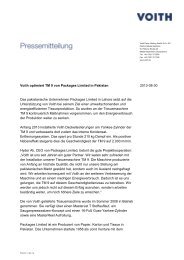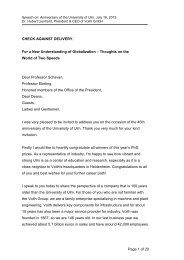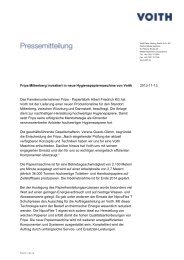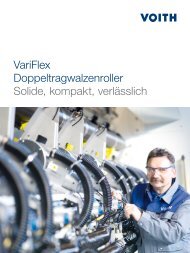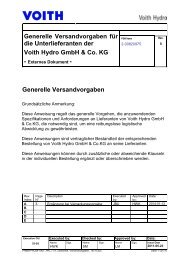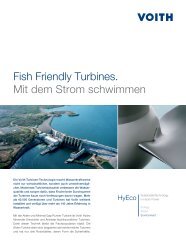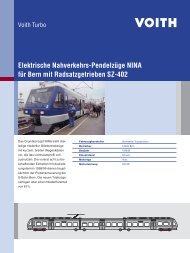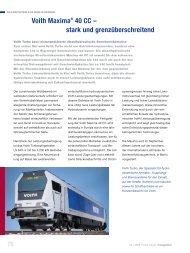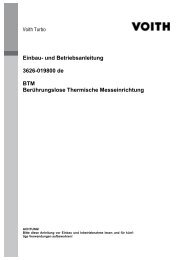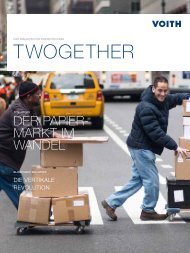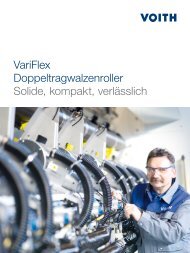2 Water for life requires inventiveness I Daio Paper Mishima ... - Voith
2 Water for life requires inventiveness I Daio Paper Mishima ... - Voith
2 Water for life requires inventiveness I Daio Paper Mishima ... - Voith
Create successful ePaper yourself
Turn your PDF publications into a flip-book with our unique Google optimized e-Paper software.
must remain stable and at adequate<br />
levels to limit the consumption of chemicals.<br />
In addition, drainage control is<br />
targeted to prevent sheet sealing or<br />
hydraulic sheet <strong>for</strong>ming defects.<br />
For the ideal <strong>for</strong>mation and control of<br />
two-sidedness in the counter blade of<br />
the <strong>for</strong>mer, the condition of the outer<br />
layers of the sheet as well as the remaining<br />
fluid core have to be adjusted<br />
carefully.<br />
The magnitude of this challenge becomes<br />
clear when considering the time<br />
required to <strong>for</strong>m the sheet. In the case<br />
of a modern, high speed paper machine,<br />
75-80% of the stock volume is already<br />
dehydrated, that is, the water is<br />
separated from the fibers after approximately<br />
20 milliseconds. After another<br />
40 milliseconds, the sheet has already<br />
reached the point of immobility, meaning<br />
that the fibers have reached their<br />
final position in the sheet. The main<br />
properties of the paper, with the<br />
38%<br />
6%<br />
Drycontent after <strong>for</strong>mer 19.8%<br />
100%<br />
26 I 2008 I <strong>Voith</strong> <strong>Paper</strong> I twogether<br />
6%<br />
35%<br />
exception of the outermost surface<br />
layers, are now <strong>for</strong>med.<br />
Dewatering through the <strong>for</strong>ming<br />
fabrics produces a fiber mat on the<br />
paper side of the woven surfaces:<br />
Step one of sheet <strong>for</strong>mation. Here, the<br />
screen design plays an important role<br />
in the sheet <strong>for</strong>ming process.<br />
What requirements does the<br />
<strong>for</strong>ming fabric have to meet?<br />
They must contribute to improved<br />
paper quality under the extreme<br />
conditions of the paper machine.<br />
For publication grades such as<br />
newsprint or LWC a high percentage<br />
of waste furnishes are used:<br />
• Improved dye absorption or color<br />
penetration, an important quality<br />
criterion of printed paper, <strong>requires</strong> a<br />
highly symmetrical and densified<br />
sheet structure with a low porosity.<br />
3%<br />
12%<br />
Dewatering benchmarked with super fine SSB. Dewatering with PrintForm HS.<br />
42%<br />
3%<br />
• Improved surface topography of<br />
the fabric is necessary to enhance<br />
the surface roughness and visual<br />
properties of the sheet.<br />
Both of these quality criteria must<br />
also be considered in combination<br />
with other machine sections, which<br />
also have significant effects on the<br />
sheet.<br />
The basic requirements <strong>for</strong> a consistent<br />
sheet structure, good <strong>for</strong>mation,<br />
minimal marking by the <strong>for</strong>ming<br />
fabrics have to be met in terms of<br />
sheet quality. The speed-specific<br />
requirements include the lowest<br />
possible water transport by the<br />
<strong>for</strong>ming fabric and adequate <strong>life</strong>time.<br />
Too much water transport by the<br />
<strong>for</strong>ming fabrics at high machine<br />
speeds would result in a heavy<br />
discharge of water and soiling of the<br />
machine which can seriously effect<br />
runnability efficiency.<br />
Drycontent after <strong>for</strong>mer 20.3%<br />
100%<br />
5%<br />
37%<br />
3%<br />
10%<br />
PRoDUCTs<br />
39





